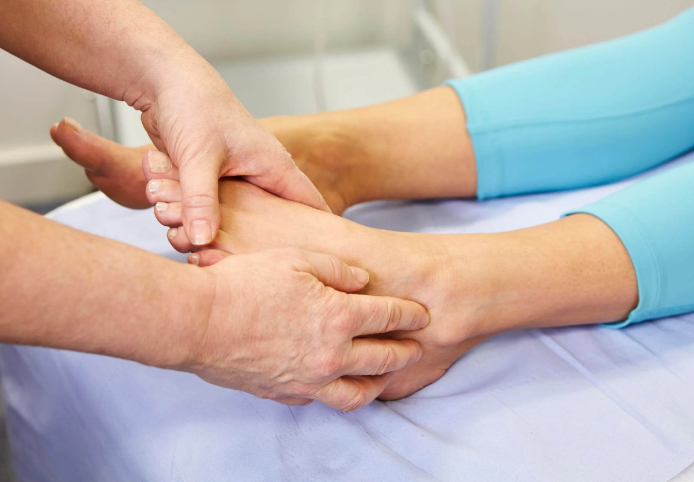
Does Kinesiology tape have a positive effect on ankle stability?
Kinesiology taping has become a popular treatment among athletes and amateurs alike over the last decade, even though its clinical benefits are still being investigated.[1]
There have been many proposed benefits to taping over the years, including: improved healing, reduced muscle fatigue, reduced delayed-onset muscle soreness, pain inhibition and improvement of lymphatic drainage and blood flow.[2]
Do you use Kinesiology tape for ankle stability? A recent study might make you think otherwise.
What is Kinesiology tape?
Taping and strapping have been used for years by people looking to prevent and treat sporting injuries. Kinesiology tape was developed in the 1970’s by a Japanese Chiropractor with the intention of fixing pain and improving the healing in soft tissues.[3]
Kinesiology tape is a thin, stretchy, elastic cotton strip that is almost identical to human skin in both thickness and elasticity. Therapeutic kinesiology tape has been purported to benefit a wide variety of musculoskeletal and sports injuries, plus inflammatory conditions including:
- Tendinopathy
- Acute low back pain
- Muscle strains
- Patella femoral pain syndrome
- Plantar fasciitis
- Osteoarthritis
- Shoulder Impingement and many other conditions
Contraindications of Kinesiology tape include:
There are some considerations to think of when using kinesiology tape. First, never blow dry the tape as the adhesive can heat quickly and burn your skin. Second, be careful when removing the tape to avoid irritation.
- Over open wounds or skin lesions
- Adhesive allergies
- Infants, toddlers or children with communication issues
- Diabetics
- Older population (fragile skin)
- Pregnancy
- Ulna side of the elbow or posterior knee
Is kinesiology tape scientifically backed by evidence?
As the popularity of kinesiology tape has grown, there have been a number of studies and reviews that have investigated its clinical uses. However, the quality of evidence is insufficient in supporting the use of taping as a stand-alone treatment.
A recent systematic review identified 12 randomised controlled trials of Kinesio Taping for various musculoskeletal conditions.[4] All of these trials demonstrated either no effect of Kinesio Taping or a clinically trivial effect. Randomised trials published more recently than this review have further indicated a general lack of effect from Kinesio Taping for more although perhaps not all musculoskeletal conditions.[5]
Is Kinesio Taping effective for improving lateral ankle stability?
Kinesiology taping for ankle stability appears to be based more on theory than science. According to researchers at the Institute of Motion Analysis & Research (IMAR):[6]
- Kinesiology tape had no effect on the peak muscle activity, the average muscle activity or the muscle latency for the peroneus longus or tibialis anterior during a sudden ankle inversion.
- Shoes increased all the mentioned variables during a sudden ankle inversion. Results of note are an increased activity of the tibialis anterior, a prolonged peroneus longus latency and a shortened latency from peroneus longus activation to tibialis anterior activation.
- Therefore, kinesiology tape appears to have no effect on ankle stability while shoes appear to be detrimental.
- It is hoped that the results of this study can be used by athletes, patients, clinicians and researchers alike to make informed decisions.
See a physio for ankle injury rehabilitation
There are lots of variables when it comes to ankle rehabilitation, such as the level of instability, precise area of injury and type of activities you want to return to. It is also very important to note that repeat ankle sprains are much more common without proper rehabilitation and you should not rely on bracing/taping alone. The main components of a physio designed rehab program will focus on improving:
- range of motion,
- strengthening,
- balance and proprioceptive
- Education and knowledge of preventative exercises as well as proper acute management
[1] Nunes GS, Vargas VZ, Wageck B. Kinesio taping does not decrease swelling in acute, lateral ankle sprain of athletes: a randomised trial. J Physiother. 2015;61:28–33.
[2] Basset KT, Lingman SA, Ellis RF. The use and treatment efficacy kinaesthetic taping for musculoskeletal conditions: a systematic review. New Zealand Journal of Physiotherapy 2010;38(2):56-62.
[3] Kinesio Taping Association International. Kinesio HK:The original from Dr. Kenzo Kaze since 1979. Kinesio Taping
[4] . Parreira PdCS. Costa LdCM. Hespanhol Junior LC, Lopes AD, Costa LOP. Current evidence does not support the use of Kinesio Taping in clinical practice: a systematic review. J Physiother. 2014;60:31–39.
[5] . Parreira PdCS. Costa LdCM. Takahashi R, Hespanhol Junior LC, da Luz Junior MA, da Silva TM, Costa LOP. Kinesio Taping to generate skin convolutions is not better than sham taping for people with chronic non-specific low back pain: a randomised trial. J Physiother. 2014;60:31–39.
[6] Slevin ZM, Arnold GP, Wang W, et al Immediate effect of kinesiology tape on ankle stability BMJ Open Sport & Exercise Medicine 2020;6:e000604. doi: 10.1136/bmjsem-2019-000604



